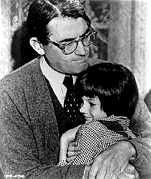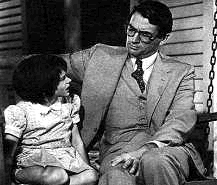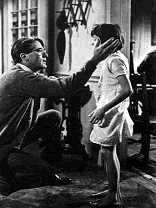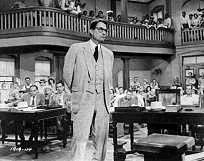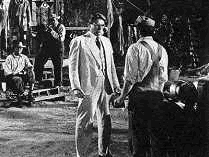TO KILL A MOCKINGBIRD: SEEING THE FILM THROUGH THE LENS OF MEDIA LITERACY
© 2006 Frank Baker
Download this page as an Adobe (pdf) document
CAMERA SHOTS/CINEMATOGRAPHY
The exact shot framed by the cinematographer can communicate many things to the viewing audience. (TKAM cinematographer Russell Harlan was nominated for an Academy Award in the category “Best Black-and-White Cinematography” for his work on this film.) The framing of a particular shot can communicate power or weakness, for example.
Other considerations-
Students could also notice:
– high and low angle shots
– when the camera moves and why
– the distance between camera and actor or action.
“Often a low angle reinforces the sense that the subject is large
or dominant or imposing or powerful, but not always.”
With the camera low-shooting UP– it gives the audience the impression that someone is larger, towering, more important or powerful
“Often a low angle reinforces the sense that the subject is large
or dominant or imposing or powerful, but not always.”1
With the camera high-shooting DOWN– it gives the audience the impression that someone is smaller, less significant, helpless, or vulnerable
“…a high angle does not always make the subject(s) seem small,
vulnerable, or weak, though in many contexts it does.” 1
Close Ups (primarily faces, signify intimacy)2
|
|
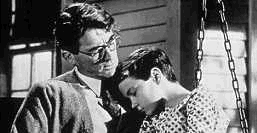 |
Images above from TCM Essentials website
Medium Shots (most of body, personal relationship)2
|
|
|
Wide/Long/Establishing Shots
(setting & characters; context, scope, public distance)2
|
|
|
Grammar of Television (Berger) can also be applied to film 3
| Signifier (shot) | Definition | Signified |
| close-up | face only | intimacy |
| medium shot | most of the body | personal relationship |
| long shot | setting & characters | context, scope, public distance |
| full shot | full body of person | social relationship |
| pan down | camera looks down | power, authority |
| pan up | camera looks up | smallness, weakness |
| zoom in | camera moves in | observation, focus |
| fade in | image appears on blank screen | beginning |
| fade out | image screen goes blank | ending |
| cut | switch from one image to another | simultaneity, excitement |
| wipe | image wiped off screen | imposed |
| Learn more about camera shots, focus, lighting and other techniques in the text: Reading In The Dark, Using Film As A Tool in the English Classroom, by John Golden, published by NCTE |
Recommended Links
Camera shots
Film Language: Use of the Camera
The Grammar of TV & Film
Making Movies Make Sense: Framing
Seeing Through the Image: Cinematography



